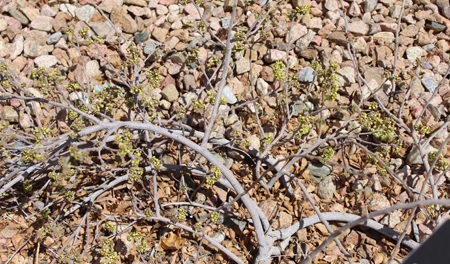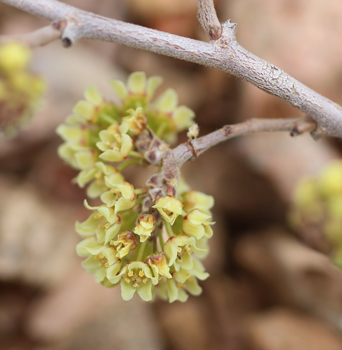The Bush
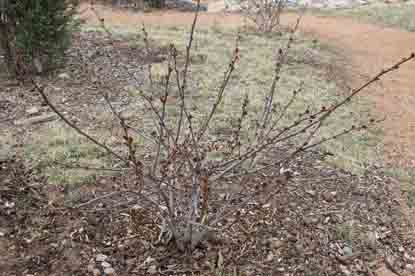 |
 |
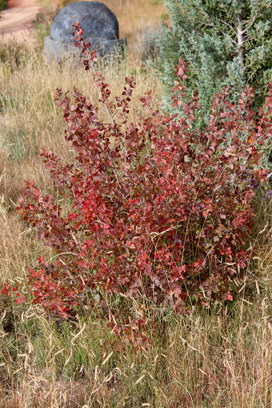 |
| Winter |
Spring |
Fall |
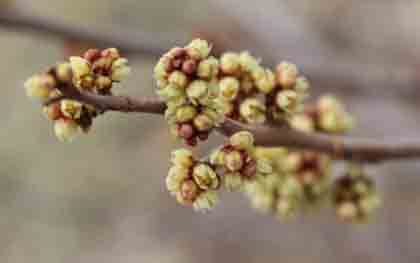 |
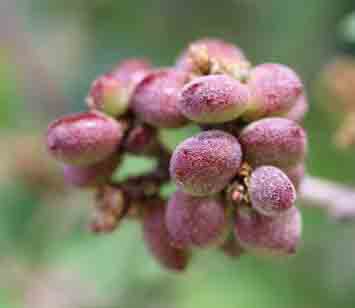 |
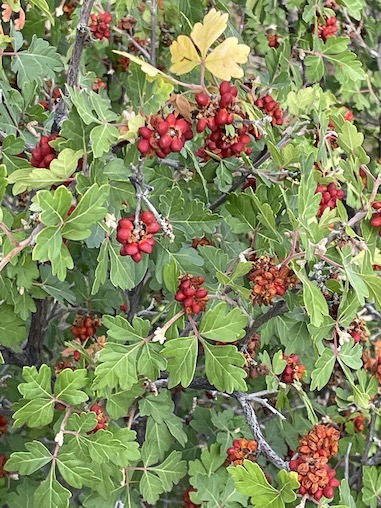 |
| The flowers | The fruit | Leaves & fruit |
Sumac, Three Leaf 'Autumn Amber' (Prostrate Sumac) -
Rhus trilobata
Description
"Rhus trilobata is a shrub in the sumac genus (Rhus) with the common names skunkbush sumac,[1] sourberry, skunkbush, and three-leaf sumac. It is native to the western half of Canada and the Western United States, from the Great Plains to California and south through Arizona extending into northern Mexico. It can be found from deserts to mountain peaks up to about 7,000 feet (2,100 m) in elevation."
"This Rhus species closely resembles other members of the genus that have leaves with three "leaflets" ("trifoliate" leaves). These include Rhus aromatica, native to eastern North America, and western poison-oak. The shape of the leaflets and the habit of the shrub make this species, like some other Rhus, resemble small-leafed oaks (Quercus)."
"The Rhus trilobata leaves have a very strong scent when crushed. The aroma is medicinal or bitter, disagreeable enough to some to have gained the plant the name skunkbush. The leaves are green when new and turn orange and brown in the fall. The twigs are fuzzy when new, and turn sleek with age. The flowers, borne on small catkins ("short shoots"), are white or light yellow. Edible fruit, the plant yields hairy and slightly sticky red berries which have an aroma similar to limes and a very sour taste. The acidity comes from tannic and gallic acids. The flowers are animal-pollinated and the seeds are dispersed by animals that eat the berries. The shrub also reproduces vegetatively, sending up sprouts several meters away and forming thickets." (Wikipedia)
Ethnobotanical Uses
Food:
"Fruits are hard and sour. Lightly steep berries for sour tea, or use as a lemon juice substitute in guacamole, gelatin, or whenever a lemon-sour flavor is required." (Seebeck 87)
"In my early youth at Fort Whipple, Arizona, I saw Apache women make bread out of ground lemita berries, and at present, the Tewa Indians eat its fruit whole or ground. Since the duty of collecting its stems for basketmaking, and its fruit for food, nearly always fell to the women doubtless the accounts for its popular name of squaw bush."(Curtin 96)
"Many travelers in this region (Ciruela) have found relief from thirst by sucking its acid-tasting berries which stimulate the flow of saliva, and many inhabitants make a refreshing beverage from it fruit, particularly welcome during the heat of summer days."(Curtin 97)
"Patrick Toya of Jemez (Pueblo) describes how some of the older folks still harvest berries and put them in tortillas to make a sandwich."(Dunmire and Tierney 139)
"Skunkbush fruits were eaten raw (sometimes ground with a little water) or boiled or they were dried for later use and ground into meal. The berries and meal were often mixed with other foods, especially sugar and roasted corn."(Kershaw 79)
"When we go for elderberries we also gather a bushel or two of sumac. Formerly, we only used it to make a cooling drink very like pink lemonade to ease us throughout the August 'dog days.' The hard fruit of the sumac is covered with tiny, acid red hairs. This is malic acid, the same acid found in unripe apples, and it is readily soluble in water. Try to gather your sumac before hard rains wash out most of the acid. The American Indians liked this cool, sour drink so well they used to gather large quantities of the heads when they were in their prime and dry them indoors. so they could make this beverage all winter. --- Always strain this juice through several thicknesses of cloth to remove all the fine hairs. Sweeten to taste, it is quite as palatable as lemonade." (Gibbons, Wild Asparagus 90-1)
"Sumac 'lemonade' is just the thing to take the edge off a hard afternoon. Pick over a generous handful of the red berries, drop them into a pan and mash them slightly, cover with boiling water, and allow to steep away from any heat until this is well colored. Then strain through two thicknesses of cloth to remove the fine hairs. Sweeten to taste, then serve the so-called Indian lemonade hot or cold. The berries are best for this in late summer and early fall." (Angier 218)
Medicine:
"The Spanish-Americans of New Mexico have found that the plant may be beneficial to them. To make the hair grow, after shampooing, they rinse The people of Ciruela grind the dry bark into a powder and rub it on a sore mouth. Moreover, they say that the gum from the bush is good to chew. (Curtin 97)
"After seeing our slide show on wild plants at the Tesuque Pueblo senior center, some members offered that they used the crushed leaves of threeleaf sumac as a foot powder and a deodorant."(Dunmire and Tierney 139)
"The leaves were chewed to cure stomachaches or were boiled to make an contraceptive tea that was said to induce impotence. Skunkbush leaves were also used in poultices to relieve itching. Tea made by boiling the root bark was taken to aid delivery of the afterbirth. The fruits were boiled and their oil, skimmed from the surface, was used to prevent hair loss."(Kershaw 79)
"It was said that if children placed sumac on their heads, they would stop growing. --- Twigs from the east side of the shrub were woven into the form of an owl, which was hung on the west side of the tipi smoke hole. The owl, moving up and down in the smoke, was used to scare children and make them behave. Making an owl was a sure sign that it would rain."(Kershaw 79)
"(Cheyenne) Plant used to protect the hands when removing dog meat from a boiling pot. Leaves used for head colds. Decoction of leaves taken as a diuretic. Plant used for bleeding. 'Old man took this medicine and bore a child (an aphrodisiac?) Fruit chewed for toothaches. (Hopi) Twigs used for ceremonial purposes. Roots used as a deodorant. Buds used on the body as a medicinal deodorant or perfume. Compound containing root used for 'consumption.' (Navajo, Kayenta) Plant used as a lotion for poison ivy dermatitis. Plant used for bowel troubles. (Navajo, Ramah) Leaves chewed for stomachache. Decoction of leaves taken to induce impotency, as a means of contraception. Poultice of leaves used for itch and decoction of fruits used to prevent falling hair. Leaves chewed for stomachache." (Moerman 474)
Other Uses:
"Squawbush stems are good for basketmaking, and the leaves were reportedly used as a tobacco substitute."(Seebeck 87)
"With the possible exception of the various willows, squaw bush is the most widely used shrub in the making of Indian baskets. The warp is formed from the peeled branches, and for a weft and sewing material in the weaving of coiled baskets the branch usually is split into three pieces, the bark and brittle tissue next to the pith are removed, leaving a flat, tough strand."(Curtin 96)
"According to Paul Standley, the Navajo made a black dye from a decoction of its leaves and berries when combined with the calcinated gum of the pinion, whereas the Spanish-Americans employed the twigs and leaves for the same purpose."(Curtin 97)
"The new soots are straight, long, and supple, but when dry they become hard and rigid, making them ideal for arrow shafts, among other implements."(Dunmire and Tierney 139)
"He (Patrick Toya of Jemez Pueblo) also says that in the old days the branches were shaped for infants' backboards and crib hoods, with cheesecloth netting then draped over them."(Dunmire and Tierney 139)
Internet Resources
